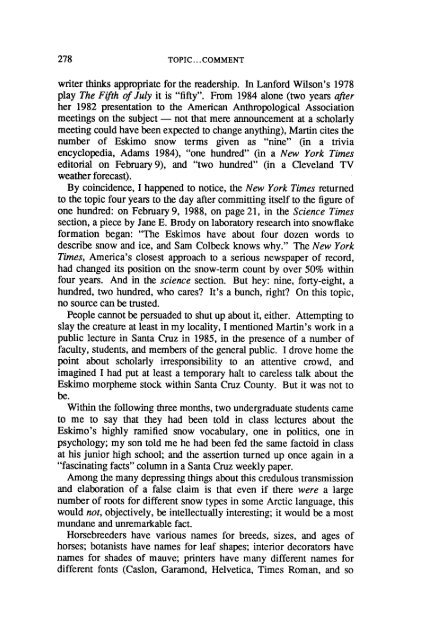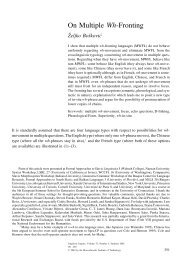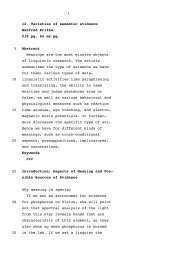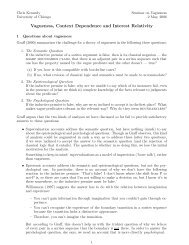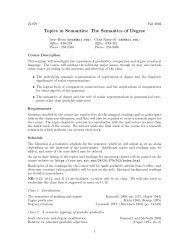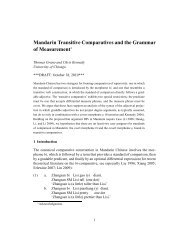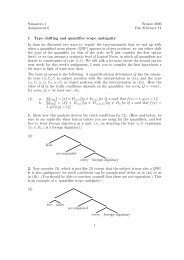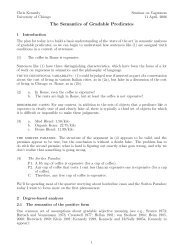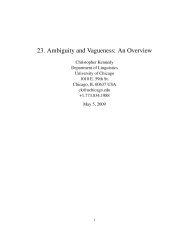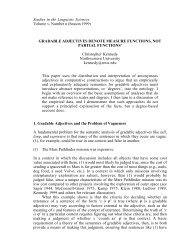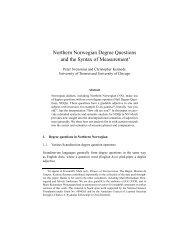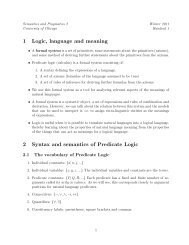The great Eskimo vocabulary hoax
The great Eskimo vocabulary hoax
The great Eskimo vocabulary hoax
You also want an ePaper? Increase the reach of your titles
YUMPU automatically turns print PDFs into web optimized ePapers that Google loves.
278 TOPIC... COMMENTwriter thinks appropriate for the readership. In Lanford Wilson's 1978play <strong>The</strong> Fifth of July it is "fifty". From 1984 alone (two years afterher 1982 presentation to the American Anthropological Associationmeetings on the subject -- not that mere announcement at a scholarlymeeting could have been expected to change anything), Martin cites thenumber of <strong>Eskimo</strong> snow terms given as "nine" (in a triviaencyclopedia, Adams 1984), "one hundred" (in a New York Timeseditorial on February 9), and "two hundred" (in a Cleveland TVweather forecas0.By coincidence, I happened to notice, the New York Times returnedto the topic four years to the day after committing itself to the figure ofone hundred: on February 9, 1988, on page 21, in the Science Timessection, a piece by Jane E. Brody on laboratory research into snowflakeformation began: "<strong>The</strong> <strong>Eskimo</strong>s have about four dozen words todescribe snow and ice, and Sam Colbeck knows why." <strong>The</strong> New YorkTimes, America's closest approach to a serious newspaper of record,had changed its position on the snow-term count by over 50% withinfour years. And in the science section. But hey: nine, forty-eight, ahundred, two hundred, who cares? It's a bunch, right? On this topic,no source can be trusted.People cannot be persuaded to shut up about it, either. Attempting toslay the creature at least in my locality, I mentioned Martin's work in apublic lecture in Santa Cruz in 1985, in the presence of a number offaculty, students, and members of the general public. I drove home thepoint about scholarly irresponsibility to an attentive crowd, andimagined I had put at least a temporary halt to careless talk about the<strong>Eskimo</strong> morpheme stock within Santa Cruz County. But it was not tobe.Within the following three months, two undergraduate students cameto me to say that they had been told in class lectures about the<strong>Eskimo</strong>'s highly ramified snow <strong>vocabulary</strong>, one in politics, one inpsychology; my son told me he had been fed the same factoid in classat his junior high school; and the assertion turned up once again in a"fascinating facts" column in a Santa Cruz weekly paper.Among the many depressing things about this credulous transmissionand elaboration of a false claim is that even if there were a largenumber of roots for different snow types in some Arctic language, thiswould not, objectively, be intellectually interesting; it would be a mostmundane and unremarkable fact.Horsebreeders have various names for breeds, sizes, and ages ofhorses; botanists have names for leaf shapes; interior decorators havenames for shades of mauve; printers have many different names fordifferent fonts (Caslon, Garamond, Helvetica, Times Roman, and so


